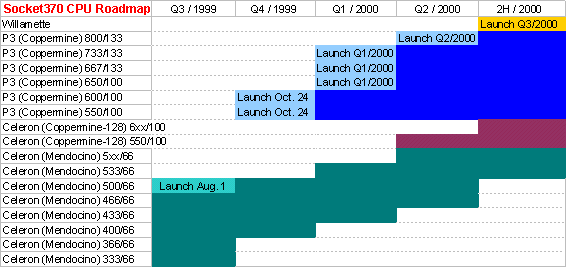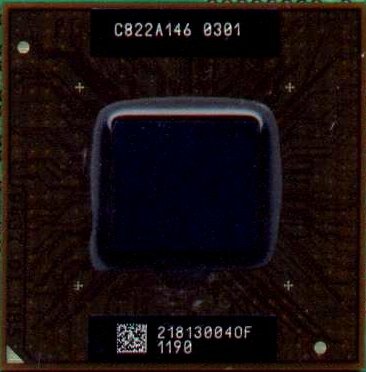Intel Roadmap Update June 1999 Part 2: Desktop CPU Roadmaps
Socket 370
Socket370 has got a bright future ahead of it, as you can see in the following overview. The days of Slot1 are counted and why wouldn't we all love to embrace Socket370 as our basic platform? It offers a much better price point and the same or soon even better performance.
Again I included Willamette here too, although it will most likely use neither Slot1 nor Socket370, but it will be found in the same consumer space as where we find PIII and Celeron right now.
Pentium III (Coppermine) for Socket370:
As already mentioned in the highlights-section, with Coppermine, Pentium III can go `back' into the socket-package and it will. The only difference to the already known Socket370-package of Celeron will be that Coppermine will come in a `flip-chip'-package. This package is many of you already known from Pentium III, it simply says that the chip-silicon is not covered by any metal-cover, but the heat sink gets attached directly to the `backside' of the very silicon, to offer a better heat dissipation.
This is what a `flip-chip' looks like.
As you can see from above roadmap, the launch of Coppermine for Socket370 will be delayed. Intel will start releasing Pentium III 550/100 and 600/100 some 6 weeks after the Coppermine launch for Slot1. You'll have to wait even longer for the official launch of Coppermine Socket370-CPUs for 133 MHz FSB. This makes me wonder what `810e' is supposed to be for. Intel seems honestly to believe that people will plug their beautiful and expensive new Slot1-Coppermine-PIII into an 810e-platform? I wonder how much of intoxication it will take to make customers believe in that funny combination.
Celeron (Coppermine-128):
Get Tom's Hardware's best news and in-depth reviews, straight to your inbox.
I guess you are a little bit confused to find the name `Coppermine' even in combination with the name `Celeron'. Well, the explanation is pretty simple. Since we've just learned that Intel's `Streaming SIMD Extensions' are `indispensable' already now (which I didn't know so far), Intel thinks that the poor Celeron-user deserves his portion of SSE as well. Now we know that the current Celerons using the `Mendocino'-core are a Pentium II core plus 128kB on-die L2-cache. Coppermine is Pentium II core plus SSE plus 256 kB on-die L2-cache. The logical consequence would be that the new Celeron with SSE enhancement is nothing than Pentium II core plus SSE plus 128 kB on-die L2-cache. This is equal to a Coppermine-core minus 128 kB L2-cache and there we are, Intel calls that `Coppermine-128'. You may be surprised why we have to wait until Q2 next year until Intel will bless us with a SSE-enhanced Celeron. The roadmap has the following answer: "Strong yields of Mendocino have pushed Coppermine-128 later into Q1'00 " - I guess it's too bad for us poor customers that `strong yields have pushed', otherwise Celeron would have received the SSE-intoxication-blessings earlier.
Tomorrow you'll get the Desktop Chipset Roadmap, with some more sharp, but `indispensable' comments from me and the Mobile CPU Roadmap, followed by the Server CPU and Chipset Roadmap as well as the pricing. See ya then!

